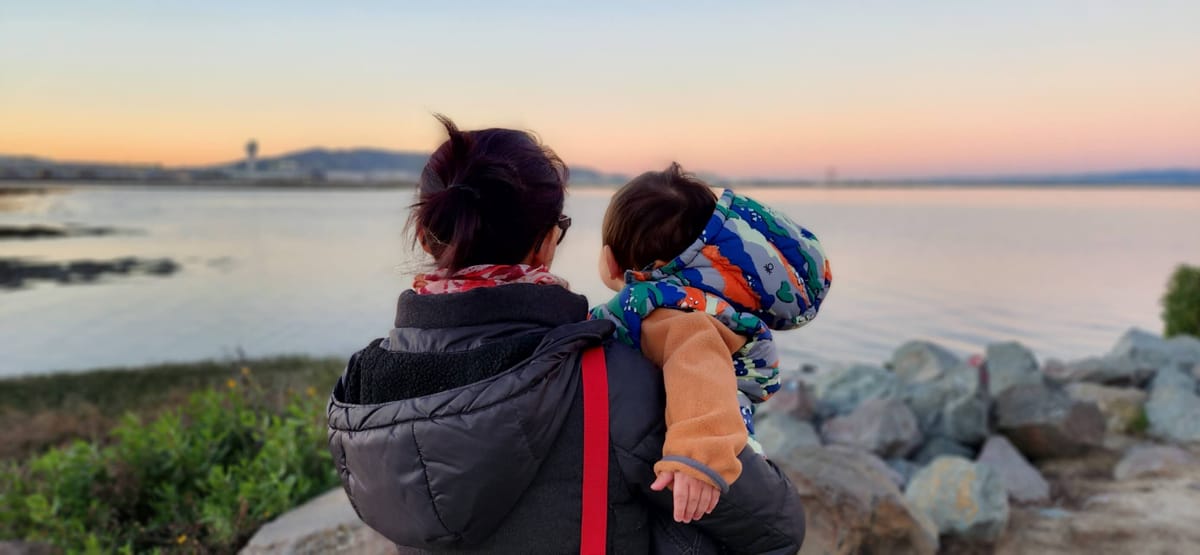A Strong Back: Part 1
The spine doctor warned me that pregnancy would probably make disc herniation worse, especially if I wasn’t diligent about treatment. It turns out he was wrong.

A Strong Back, the September 2025 issue of Fieldnotes from a Watcher, is dedicated to those who've courageously endured chronic pain. This is a personal story, not medical advice. See full disclaimer at the end.
Summer 2022. Appalled by what he saw on the MRI scan, the sports doctor diagnosed me with L4-L5 and L5-S1 disc herniation in the lumbar spine.
We had just moved out of San Francisco, our home of almost 10 years, to a Peninsula town called Burlingame. Over a month of undefined lower back pain followed shortly after we settled into the new house. Weekly physical therapy and countless DIY trial and error ensued, including large amounts of tiger balm, numerous back brace or wedge pillow purchases, and endless YouTube videos offering contradicting advice. With little to no relief, I knew something was different this time from my usual flare-ups that inflicted only minor and temporary discomfort over the years.
Having finally received a diagnosis was a weight off my shoulders. The doctor suggested that I continue physical therapy, but also start a cortisone injection to “put out the fire” first and then “aggressive” acupuncture sessions two to three times a week.
At the time, my husband and I were trying to conceive again after painfully losing our daughter during pregnancy about a year before. It was the most inopportune time to be severely injured with not one but two herniated discs, along with the debilitating sciatica that followed. The doctor warned me that pregnancy would probably make things worse, especially if I wasn’t diligent about treatment.
It turns out he was wrong. Not only did my disc herniation lessen right before we conceived after weeks of physical therapy and acupuncture, I also didn’t relapse during pregnancy. In fact, now two years postpartum, my body and back are stronger than ever. The stamina necessary to carry a 25-pound wiggly toddler with relative ease would be unthinkable to my former, childless self who was unaware and careless of her own body.
What changed?
The short answer is just practice, day in and day out, with no option of giving up. The reality of raising a little human being is that it’s a marathon, and putting one foot in front of the other is the only way to run a marathon. Every single day postpartum has been a gym day.
Here’s an example: My husband and I choose to hold our son as much as possible. Before he started taking his first steps around 14 months old, we walked, cooked, ate meals, and ran errands daily while carrying our boy in our arms or in a baby carrier. We also rocked him to sleep almost every single night until he turned 22 months old and decided to fall asleep on his own. In turn, our son grew attached to these physical contacts, making them harder to break.
These self-imposed demands on our bodies are like strength training; we simply have to figure out a way to get stronger as our boy grows heavier. A protracted history of lower back pain and lumbar injury just two years before regularly makes me nervous. Every time sciatica flares up, I’d wonder if I’ve reached the end of holding my son. Stroller and car rides bring respite, but I’m stubborn. Through repeated strength training, my body and I inevitably grow much closer.
“You will get stronger, I promise. It’s like a full-body workout every day.” I told a dad who bought our baby carrier from Craigslist when we eventually no longer needed it. His daughter was four months old and wanted to be held all the time.
The body isn’t indestructible of course. Unsurprisingly, my back is often sore with low core muscle strength from giving birth and scar tissue that’s prone to disc re-injury. But it seems to be a miracle that almost three years of a pregnancy and postpartum marathon, along with its intense physical toll on the body, didn’t worsen a terribly painful lumbar injury. I’m often in awe of how much the body is capable of.
Biology is magical.
Continue to Part 2 here.
Disclaimer: The content of this essay is based on personal experience. It is for storytelling and informational purposes only and should not be considered medical advice. I am not a medical professional, and any decisions about your specific situation, diagnosis, treatment, or health care should be made in consultation with qualified medical practitioners.